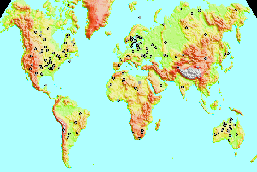Impacts on Earth
 We are very lucky today that the majority of debris, which enters Earth from space, is small in size. However, a small fraction of the pieces do survive the journey. These are meteorites, as we have discussed in the previous section. Meteorites usually cause not too severe damage than a hole in a house roof or a small crater in the ground.
We are very lucky today that the majority of debris, which enters Earth from space, is small in size. However, a small fraction of the pieces do survive the journey. These are meteorites, as we have discussed in the previous section. Meteorites usually cause not too severe damage than a hole in a house roof or a small crater in the ground.
 On the other hand, things were not always this fortunate. During the past, Earth has been hit by much larger objects, which have left scars on the surface. For example, some scientists believe that the disappearance of the Dinosaurs about 65 million years ago was caused by the impact of a large asteroid in an area now covered by the Indian Ocean. Some also believe that a huge body (possibly the size of a planet) caused a large piece to fracture off our planet and form the Moon, which we see today. Here are several impact sites on Earth that we have been able to identify.
On the other hand, things were not always this fortunate. During the past, Earth has been hit by much larger objects, which have left scars on the surface. For example, some scientists believe that the disappearance of the Dinosaurs about 65 million years ago was caused by the impact of a large asteroid in an area now covered by the Indian Ocean. Some also believe that a huge body (possibly the size of a planet) caused a large piece to fracture off our planet and form the Moon, which we see today. Here are several impact sites on Earth that we have been able to identify.
Here are some famous craters from around the world:
 Barringer, Arizona, USA.
Barringer, Arizona, USA.
Barringer is 1.2 km across, and is about 49,000 years old. It is possibly the most famous terrestrial impact crater,
 Wolfe Creek, Western Australia.
Wolfe Creek, Western Australia.
This crater is less than 0.3 million years old and has a diameter of 0.9 km.
Return to top


